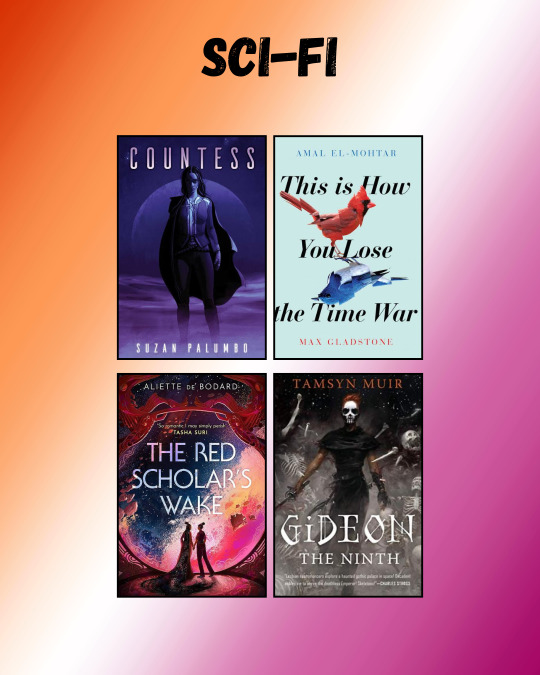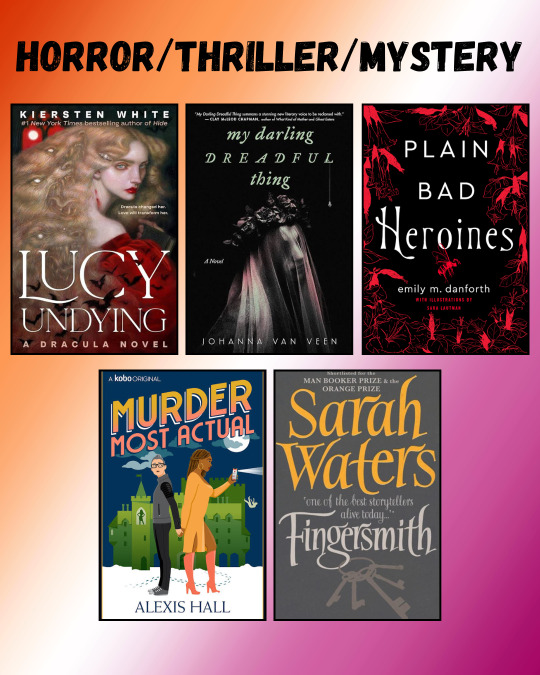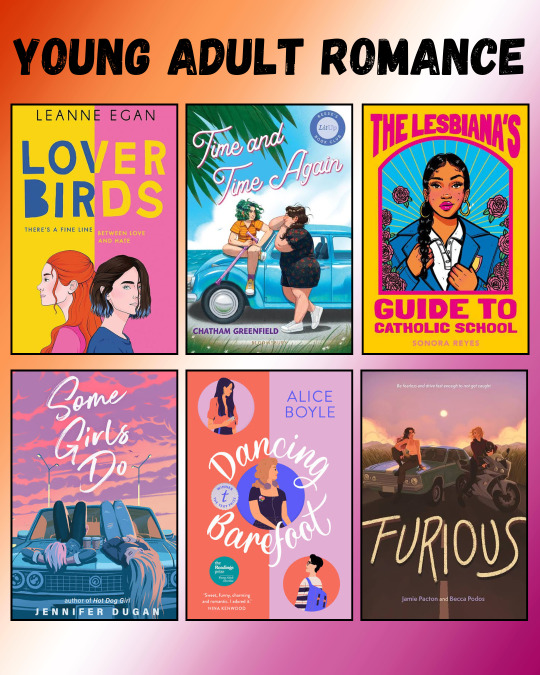I'm barbex, I have a tag for everything. This tumblr is for writing advice, writing resources and indie publishing. Some content may be unsuitable for minors. All writing is writing, fanfic is valid. I'm german, write in english, and I'm older than you. Feel free to ask me things! she/her. I also write but I'm too shy/anxious/panicked to talk about my WIPs here. I run the-wip-project, fictober-event, audiobarbex. Also: fangirling: barbex, fics and original works: AO3/barbex -- barbex everywhere on the internet.
Don't wanna be here? Send us removal request.
Text





Tonight was pretty wild.
136 notes
·
View notes
Text
Friend: Don't you want to have a romance?
Me: I'm good, I have romance at home.
Romance I have at home:

27K notes
·
View notes
Link
Kristen Lamb:
Suffice to say that writing will always be tough work, and the challenges will never evaporate, only change. When we are new, pre-published authors, we are literally in the process of learning an incredibly difficult skill. While having talent is definitely an asset, it’s only one piece of a giant puzzle.
As we grow in our craft, the challenges shift. We might publish our first novel and it’s well-written. But then we have to write the next novel and the next. Then there is creating an author brand, sales, social media, formatting, covers, research, revisions, edits….AHHHHH.
Thus, writing can get really overwhelming and, if we fail to develop good habits, laziness definitely can be at the root of writer’s block. It’s just SO much easier to repaint the house than it is to knock out a thousand words, right?
I wouldn’t call it laziness but writing is indeed hard work and it’s only natural that we sometimes want to avoid doing the hard stuff.
Kristen has a lot of advice in this post on how to actually do the hard stuff.
24 notes
·
View notes
Text
One of the most common ways that I see characters who are supposed to be extremely competent not work is by not actually showing them being competent.
This is a common trope with films with the Most Competent Woman who has to train the For Some Reason More Important Man and then swiftly gets outpaced by him despite having years or decades of experience, but I also see it a fair amount in books.
Namely, it shows up when a character is supposed to be the best fighter / assassin / thief / negotiator, but to have them actually succeed at their task would make the plot of the book fall apart, so they end up being written as kind of incompetent.
There are a few ways to avoid this problem:
Don't have the story tell us that they are the best. It's more believable that they're not immediately succeeding when they're good but not amazing than when they're supposed to be the most successful ever
Have them be stopped by reasonable forces. It can be a trap or an ambush, or it can be something else that they had no way to predict or plan for, or it can be such overwhelming force that it doesn't matter how good they are. Maybe a natural disaster strikes!
Actually show their competence. Don't just tell the reader that the character is the best but actually show them doing it in the action, reliably, consistently. Show their knowledge, their experience, their skills
223 notes
·
View notes
Text
So, as I've gotten deeper into writing as a hobby again, all the reasons that made me stop doing it years ago have shown themselves once again. Bafflingly enough, it's way more difficult for me right now than it was as a rusty beginner weeks ago. Something something the learning curve:

I am totally somewhere in the "This is hard!" or "I don't know s***" zones right now (and it's where I stopped last time.) On this second go-around, I won't let it defeat me, though! Been reading little advice tidbits here and there that have been really, really helpful.
A few gems from a great discussion about the purpose of a draft that spoke to me:
Q. What makes you keep writing your first draft even though it's a complete mess?
I. Being a complete mess is the one and only job of the first draft. Proof of life. Keep going. It's like moving, which is the world's single worst activity. You box up every fucking thing in your head, and set it all out in your new space, and it's the worst day of your life when you do. And the satisfaction of moving all those boxes and finishing the laborious work is fleeting because now your new space looks like absolute garbage, and it will keep looking like a cluttered unlivable mess for months and you know it and you wonder why you even bothered moving. But you slowly unpack and organize and hang things on the wall until one day you're living in the home you always imagined.
II. Think of the mess as a puzzle that you get to have fun solving.
III. It's only a mess compared to other things you've read. But other things you've read are finished.
Stop comparing your work in progress to finished works.
It takes months or even years to finish most stories (excepting short stories and maybe novelettes). You're not going to get there on your first draft, or your second, or even your third. So, according to the words of Save the Cat! Writes a Novel, "Don't be afraid to write crap. Crap makes great fertilizer."
IV. Writing anything is an accomplishment. So many people think about, talk about, post about writing… and never do. (shush, I know I'm guilty of that at this moment!!)
Set a daily goal (words, pages, whatever). Hit it each day and take pride in JUST THAT accomplishment. It will get easier each day to reach that goal it as it becomes a habit rather than a chore.
Your story can't just exist in your head, it has to be given form. Writing it will gradually, eventually reveal what you can keep, what you must refine, and what you need to mercilessly cast away. If it's only in your head, it ALL exists, good, bad, and mediocre. Putting it in words starts the process of separating it from your mind and ego, and will start to give you some detachment and perspective for further drafts. It might start as a mewling little lump of words that drools and vomits and shits itself but by GOD you are going to raise… er, revise… that story into a fine figure of a tale.
As the sayings go, all writing is good writing. And all writing is rewriting.
#yes this is fucking real#once you get better at writing#you see more flaws#and get more critical#it's part of growing as a writer#but it's baffling sometimes
46 notes
·
View notes
Video
youtube
Reenaction of maidservants helping an 18th century English lady to dress, by National Museums Liverpool (YouTube).
I think my favourite part is the standalone pronouncement “no knickers were worn,” after which the narrator just leaves that there and moves on. Costumes curator Pauline Rushton:
“Getting ourselves dressed in the morning is one of the everyday things we all take for granted, along with brushing our hair and our teeth. But what would it feel like to have someone else dress you every day? In the 18th century, provided you had enough money and could afford to pay servants, that would be the norm, especially if you were a woman. In any case, clothes could be so complicated that you wouldn’t be able to get into them easily without someone else’s assistance. Ideas about privacy and intimacy were different then too – it was normal to be touched by a servant if they were helping you wash or dress.
[…] You can see the layers of garments that were involved, beginning with the basic linen shift, followed by the stays (the corset), and the petticoats, and finishing with the fine silk gown. Many accessories were also involved in the process, including stockings, garters, separate pockets, padded bum rolls and kerchiefs for the neckline – but no drawers!
Women in England didn’t start to wear drawers until the early years of the 19th century. During the 18th century, drawers were considered unhygienic and too masculine for women because men wore them under their knee breeches. It took a long time for them to become accepted in England, with some women only adopting them as late as the 1830s.
(Blog)
339 notes
·
View notes
Text











🩷 LESBIAN BOOKS FOR EVERY READER 🩷
QOTD: What’s your favourite book with a lesbian main character?
It’s lesbian visibility week and that means it’s time to add some lesbian books to your tbr!
No matter your favourite genre, I’ve got you covered with this rec list, so no more excuses for not reading lesbian stories!
Please note that a main character is the character(s) whose POV the story is from, not love interests or other key characters.
[instagram]
Books pictured:
Slide 2: Romance:
- Ribbonwood by Ruby Landers
- Make Room for Love by Darcy Liao
- Not Just Gal Pals by Elizabeth Luly
- How You Get the Girl by Anita Kelly
- Delilah Green Doesn’t Care by Ashley Herring Blame
- Honey Girl by Morgan Rogers
Slide 3: Fantasy:
- The Priory of the Orange Tree by Samantha Shannon
- Legends & Lattes by Travis Baldree
- Her Majesty’s Royal Coven by Juno Dawson
- Can’t Spell Treason Without Tea by Rebecca Thorne
- Skysong by CA Wright
- Enemies to Booksellers by Laura Catherine
Slide 4: Romantasy:
- A Crimson Covenant by Aimee Donnellan
- Faebound by Saara El-Arifi
- Mortal Follies by Alexis Hall
- Pinned by Love by Elaine J Daniels
Slide 5: Sci-fi
- Countess by Suzan Palumbo
- This is How You Lose the Time War by Amal El-Mohtar and Max Gladstone
- The Red Scholar’s Wake by Aliette de Bodard
- Gideon the Ninth by Tamsyn Muir
Slide 6: Horror/Thriller/Mystery
- Lucy Undying by Kiersten White
- My Darling Dreadful Thing by Johanna Van Veen
- Plain Bad Heroines by Emily M Danforth
- Murder Most Actual by Alexis Hall
- Fingersmith by Sarah Waters
Slide 7: Historical
- The MoonStone Girls by Brooke Skipstone
- Tipping the Velvet by Sarah Waters
- Winter of the Wolf by Amanda Willimott
- Devotion by Hannah Kent
Slide 8: Comics/Graphic Novels
- West Coast Avengers by Thompson, Caselli and Farrell
- I Hated You in High School by Kathleen Gros
- Shades of Magic by VE Schwab
- Laura Dean Keeps Breaking Up With Me by Mariko Tamaki and Rosemarey Valero-O’Connell
- Navigating With You by Jeremy Whitley
Slide 9: Young Adult Romance
- Lover Birds by Leanne Egan
- Time and Time Again by Chatham Greenfield
- The Lesbiana’s Guide to Catholic School by Sonora Reyes
- Some Girls Do by Jennifer Dugan
- Dancing Barefoot by Alice Boyle
- Furious by Rebecca Podos and Jamie Pacton
Slide 10: Young Adult Fantasy/Romantasy
- A Dark and Hollow Star by Ashley Shuttleworth
- These Witches Don’t Burn by Isabel Sterling
- Gentlest of Wild Things by Sarah Underwood
- Girls of Paper and Fire by Natasha Ngan
- Cinderella is Dead by Kalynn Bayron
- The Merciless King of Moore High by Lily Sparks
Slide 11: Young Adult Horror/Thriller/Mystery
- The Invocations by Krystal Sutherland
- Into the Mouth of the Wolf by Erin Gough
- You’re Not Supposed to Die Tonight by Kalynn Bayron
- This is the Way the World Ends by Jen Wilde
- The Killing Code by Ellie Marney
- Every Exquisite Thing by Laura Steven
350 notes
·
View notes
Text
fuck I hate naming characters
133 notes
·
View notes
Text
People, look what I found!
This made me tear up because I am a massive food nerd.
But also, what an amazing writing reference it can be!
18 notes
·
View notes
Text

Tossing my hat into the rainbow ring~
Interested in hella gay vampires in a queernormative setting? This ain't no coming out story, they are here, they are queer, and I want more readers to love them as much as I do.
Also featuring!
Autism rep
BIPOC characters
Gender nonconformity
Trans rep
Eternal Night of the Northern Sky is available in ebook and paperback:
Amazon
These retailers
The last of the living clans in the North are forced to hunt vampires to survive in the sunless wasteland they created, until a clansman finds himself caught between vampire covens on the brink of war, and falling for one of his clan's oldest enemies.
Thanks everyone!
27 notes
·
View notes
Text
the writing brain is like a pc from 2009. cpu overheating. fans screaming. 37 tabs open. microsoft word not responding. ideas buffering. and somehow there’s a minecraft launcher running in the background for no reason.
3K notes
·
View notes
Text

'Someplace Quiet'
This piece was partly inspired by a scene from the Demon Slayer series where the protagonist (Tanjiro Kamado) find himself in a dream sequence wreathed in wisteria flowers as he wrestles his sanity and sense of self.
For collectors interested in this work, please feel free to contact [email protected]
#brbchasingdreams
prints | tutorials | my artbook
6K notes
·
View notes
Note
Any tips/advice on how to write a character with bipolar disorder?? 🙏
Writing Notes: Bipolar Disorder
Bipolar Disorder - a treatable mental health condition marked by extreme changes in mood, thought, energy, and behavior.
Not a character flaw or a sign of personal weakness.
Previously known as manic depression because a person’s mood can alternate between the “poles” of mania (highs) and depression (lows).
These changes in mood, or “mood swings,” can last for hours, days, weeks or months.
Symptoms of Bipolar Disorder
MANIA: The “Highs” of Bipolar Disorder
Symptoms of mania include:
heightened mood, exaggerated optimism and self-confidence;
excessive irritability, aggressive behavior;
decreased need for sleep without experiencing fatigue;
grandiose thoughts, inflated sense of self-importance;
racing speech, racing thoughts, flight of ideas;
impulsiveness, poor judgment, easily distracted;
reckless behavior; and
in the most severe cases, delusions and hallucinations.
DEPRESSION: The “Lows” of Bipolar Disorder
Symptoms of depression include:
prolonged sadness or unexplained crying spells;
significant changes in appetite and sleep patterns;
irritability, anger, worry, agitation, anxiety;
pessimism, indifference;
loss of energy, persistent lethargy;
feelings of guilt, worthlessness;
inability to concentrate, indecisiveness;
inability to take pleasure in former interests, social withdrawal;
unexplained aches and pains; and
recurring thoughts of death or suicide.
Types of Bipolar Disorder
There are several types of bipolar disorder. Each kind is defined by the length, frequency, and pattern of episodes of mania and depression.
Mood swings that come with bipolar disorder are usually more severe than ordinary mood swings and symptoms can last weeks or months, severely disrupting a person’s life.
For example, depression can make a person unable to get out of bed or go to work or mania can cause a person to go for days without sleep.
Bipolar I Disorder - Characterized by one or more episodes of mania or mixed episodes (which is when you experience symptoms of both mania and depression).
Bipolar II Disorder - Diagnosed after one or more major depressive episodes and at least one episode of hypomania, with possible periods of level mood between episodes.
The highs in bipolar II, called hypomanias, are not as high as those in bipolar I (manias).
Bipolar II disorder is sometimes misdiagnosed as major depression if episodes of hypomania go unrecognized or unreported.
If you have recurring depressions that go away periodically and then return, ask yourself if you also have:
Had periods (lasting four or more days) when your mood was especially energetic or irritable?
Did you feel or did others say that you were doing or saying things that were unusual, abnormal or not like your usual self?
Were you:
Feeling abnormally self-confident or social?
Needing less sleep or more energetic?
Unusually talkative or hyper?
Irritable or quick to anger?
Thinking faster than usual?
More easily distracted/having trouble concentrating?
More goal-directed or productive at work, school or home?
More involved in pleasurable activities, such as spending or sex?
If so, talk to your health care provider about these energetic episodes, and find out if they might be hypomania. Getting a correct diagnosis of bipolar II disorder can help you find treatment that may also help lift your depression.
Some people with bipolar disorder may have milder symptoms.
For example, you may have hypomania instead of mania. With hypomania, you may feel very good and find that you can get a lot done.
You may not feel like anything is wrong. But your family and friends may notice your mood swings and changes in activity levels.
They may realize that your behavior is unusual for you.
After the hypomania, you might have severe depression.
Your mood episodes may last a week or 2 or sometimes longer. During an episode, symptoms usually occur every day for most of the day.
Diagnosis
BIPOLAR I DISORDER is diagnosed when a person experiences a manic episode. During a manic episode, people with bipolar I disorder experience an extreme increase in energy and mood changes, including feeling extremely happy or uncomfortably irritable. Some people with bipolar I disorder also experience depressive or hypomanic episodes, and most people with bipolar I disorder also have periods of neutral mood.
Symptoms of Bipolar I Disorder
Manic Episode. A manic episode is a period of at least 1 week when a person is extremely high-spirited or irritable most of the day for most days, possesses more energy than usual, and experiences at least 3 of the following changes in behavior:
Decreased need for sleep (e.g., feeling energetic despite significantly less sleep than usual).
Increased or faster speech.
Uncontrollable racing thoughts or quickly changing ideas or topics when speaking.
Distractibility.
Increased activity (e.g., restlessness, working on several projects at once).
Increased risky or impulsive behavior (e.g., reckless driving, spending sprees, sexual promiscuity).
These behaviors must represent a change from the person’s usual behavior and be clear to friends and family. Symptoms must be severe enough to cause dysfunction in work, family, or social activities and responsibilities. Symptoms of a manic episode commonly require hospital care to ensure safety.
During severe manic episodes, some people also experience disorganized thinking, false beliefs, and/or hallucinations, known as psychotic features.
Hypomanic Episode. A hypomanic episode, or hympomania, is characterized by less severe manic symptoms that need to last only 4 days in a row rather than a week. Hypomanic symptoms do not lead to the major problems in daily functioning that manic symptoms commonly cause.
Major Depressive Episode. A period of at least 2 weeks in which a person experiences intense sadness or despair or a loss of interest in acivities the person once enjoyed and at least 4 of the following symptoms:
Feelings of worthlessness or guilt.
Fatigue.
Increased or decreased sleep.
Increased or decreased appetite.
Restlessness (e.g., pacing) or slowed speech or movement.
Difficulty concentrating.
Frequent thoughts of death or suicide.
BIPOLAR II DISORDER. To diagnose bipolar II disorder in an individual, they must have at least 1 major depressive episode and at least 1 hypomanic episode (see above). With bipolar II, it is common that people return to their usual functioning between episodes. People with bipolar II disorder often first seek treatment as a result of their depressive episodes, since hypomanic episodes often feel pleasurable and can even increase performance at work or school.
People with bipolar II disorder frequently have other mental illnesses such as an anxiety disorder or substance use disorder, the latter of which can exacerbate symptoms of depression or hypomania.
CYCLOTHYMIC DISORDER is a milder form of bipolar disorder involving many "mood swings," with hypomania and depressive symptoms that occur frequently. People with cyclothymia experience emotional ups and downs but with less severe symptoms than bipolar I or II disorder.
Cyclothymic disorder symptoms include the following:
For at least 2 years, many periods of hypomanic and depressive symptoms, but the symptoms do not meet the criteria for hypomanic or depressive episodes.
During the 2-year period, the symptoms (mood swings) have lasted for at least half the time and have never stopped for more than 2 months.
Exams and Tests. To diagnose bipolar disorder, your health care provider may do some or all of the following:
Ask whether other family members have bipolar disorder
Ask about your recent mood swings and for how long you have had them
Perform a thorough exam and order lab tests to look for other illnesses that may be causing symptoms that resemble bipolar disorder
Talk to family members about your symptoms and overall health
Ask about any health problems you have and any medicines you take
Watch your behavior and mood
Possible Causes
Experts don't know what causes bipolar disorder.
They agree that many factors seem to play a role.
This includes environmental, mental health, and genetic factors.
Bipolar disorder tends to run in families.
Researchers are still trying to find genes that may be linked to it.
Treatment and Care
Even though symptoms often recur, recovery is possible.
With appropriate care, people with bipolar disorder can cope with their symptoms and live meaningful and productive lives.
There are a range of effective treatment options, typically a mix of medicines and psychological and psychosocial interventions.
Medicines are considered essential for treatment, but themselves are usually insufficient to achieve full recovery.
People with bipolar disorder should be treated with respect and dignity and should be meaningfully involved in care choices, including through shared decision-making regarding treatment and care, balancing effectiveness, side-effects and individual preferences.
The main goal of treatment is to:
Make the episodes less frequent and severe
Help you function well and enjoy your life at home and at work
Prevent self-injury and suicide
A combination of medication and talk therapy is most helpful. Often more than one medication is needed to keep the symptoms in check.
MOOD STABILIZERS. The best-known and oldest mood stabilizer is lithium carbonate, which can reduce the symptoms of mania and prevent them from returning. Although it is one of the oldest medicines used in psychiatry, and although many other drugs have been introduced in the meantime, much evidence shows that it is still the most effective of the available treatments.
Lithium also may reduce the risk of suicide.
If you take lithium, you have to have periodic blood tests to make sure the dose is high enough, but not too high.
Side effects include nausea, diarrhea, frequent urination, tremor (shaking) and diminished mental sharpness.
Lithium can cause some minor changes in tests that show how well your thyroid, kidney and heart are functioning.
These changes are usually not serious, but your doctor will want to know what your blood tests show before you start taking lithium.
You will have to get an electrocardiogram (EKG), thyroid and kidney function tests, and a blood test to count your white blood cells.
For many years, antiseizure medications (also called "anticonvulsants") have also been used to treat bipolar disorder.
The most common in use are valproic acid (Depakote) and lamotrigine (Lamictal).
A doctor may also recommend treatment with other antiseizure medications — gabapentin (Neurontin), topiramate (Topamax), or oxcarbazepine (Trileptal).
Some people tolerate valproic acid better than lithium.
Nausea, loss of appetite, diarrhea, sedation and tremor (shaking) are common when starting valproic acid, but, if these side effects occur, they tend to fade over time.
The medication also can cause weight gain.
Uncommon but serious side effects are damage to the liver and problems with blood platelets (platelets are necessary for the blood to clot).
Lamotrigine (Lamictal) may or may not be effective for treating a depression that is active, but some studies show that it is more effective than lithium for preventing the depression of bipolar disorder.
(Lithium, however, is more effective than lamotrigine in preventing mania.)
The most troubling side effect of lamotrigine is a severe rash — in rare cases, the rash can become dangerous.
To minimize the risk, usually the doctor will recommend a low dose to start and increase dosages very slowly.
Other common side effects include nausea and headache.
ANTIPSYCHOTIC MEDICATIONS. In recent years, studies have shown that some of the newer antipsychotic medications can be effective for controlling bipolar disorder symptoms.
Side effects often have to be balanced against the helpful effects of these drugs:
olanzapine: sleepiness, dry mouth, dizziness and weight gain
risperidone: sleepiness, restlessness and nausea
quetiapine: dry mouth, sleepiness, weight gain and dizziness
ziprasidone: sleepiness, dizziness, restlessness, nausea and tremor
aripiprazole: nausea, stomach upset, sleepiness (or sleeplessness) or restlessness
asenapine: sleepiness, restlessness, tremor, stiffness, dizziness, mouth or tongue numbness.
Some of these new antipsychotic drugs can increase the risk of diabetes and cause problems with blood lipids.
Olanzapine is associated with the greatest risk.
With risperidone, quetiapine and asenapine, the risk is moderate.
Ziprasidone and aripiprazole cause minimal weight change and not as much risk of diabetes.
ANTIANXIETY MEDICATIONS. Such as lorazepam (Ativan) and clonazepam (Klonopin) sometimes are used to calm the anxiety and agitation associated with a manic episode.
ANTIDEPRESSANTS. The use of antidepressants in bipolar disorder is controversial. Many psychiatrists avoid prescribing antidepressants because of evidence that they may trigger a manic episode or induce a pattern of rapid cycling. Once a diagnosis of bipolar disorder is made, therefore, many psychiatrists try to treat the illness using mood stabilizers.
Some studies, however, continue to show the value of antidepressant treatment to treat low mood, usually when a mood stabilizer or antipsychotic medication is also being prescribed.
There are so many different forms of bipolar disorder that it is impossible to establish one general rule.
Using an antidepressant alone may be justified in some cases, especially if other treatments have not given relief. This is another area where the pros and cons of treatment should be reviewed carefully with your doctor.
PSYCHOTHERAPY. Talk therapy (psychotherapy) is important in bipolar disorder as it provides education and support and helps a person come to terms with the illness. Therapy can help between mood episodes to help people recognize the early symptoms follow a course of treatment more closely. For depression, psychotherapy can help people develop coping strategies. Family education helps family members communicate and solve problems. When families are kept involved, patients adjust more easily, are more likely to make good decisions about their treatment and have a better quality of life. They have fewer episodes of illness, fewer days with symptoms and fewer admissions to the hospital.
Psychotherapy helps a person deal with painful consequences, practical difficulties, losses or embarrassment stemming from manic behavior.
A number of psychotherapy techniques may be helpful depending on the nature of the person's problems.
Cognitive behavioral therapy helps a person recognize patterns of thinking that may keep him or her from managing the illness well.
Psychodynamic, insight-oriented or interpersonal psychotherapy can help to sort out conflicts in important relationships or explore the history that has contributed to current problems.
If left untreated, a first episode of mania lasts an average of 2-4 months and a depressive episode up to 8 months or longer, but there can be many variations. If the person does not get treatment, episodes tend to become more frequent and last longer as time passes.
Self-Care. You can also take steps to help yourself. During periods of depression, consider the following:
Get help. If you think you may be depressed, see a healthcare provider right away.
Set realistic goals and don’t take on too much at a time.
Break large tasks into small ones. Set priorities and do what you can as you can.
Try to be with other people and confide in someone. It's usually better than being alone and secretive.
Do things that make you feel better. Going to a movie, gardening, or taking part in religious, social, or other activities may help. Doing something nice for someone else can also help you feel better.
Get regular exercise.
Expect your mood to get better slowly, not right away. Feeling better takes time.
Eat healthy, well-balanced meals.
Don't drink alcohol or use illegal drugs. These can make depression worse.
It’s best to postpone big decisions until the depression has lifted. Before making big decisions, such as changing jobs or getting married or divorced, discuss it with others who know you well and have a more objective view of your situation.
People don’t snap out of a depression. But with treatment they can feel a little better day by day.
Try to be patient and focus on the positives. It may help replace the negative thinking that is part of the depression, and the negative thoughts will disappear as your depression responds to treatment.
As difficult as it may be, tell your family and friends that you are not feeling well and let them help you.
Sources: 1 2 3 4 5 6 7 8 9 ⚜ More: References ⚜ Writing Resources PDFs
Consider the above notes, and then the following tips & advice to further develop your character:
Writing about Mental Health Conditions
Character Development
You can find more details as well as some useful fact sheets in the sources. Speaking with a person/s with bipolar disorder would also lend valuable insight into your story, as well as doing further research on media portrayals of and by people with bipolar disorder. Hope this helps with your writing!
189 notes
·
View notes
Text
How to use Em Dash (—) and Semi Colon ( ; )
Since the ai accusations are still being thrown around, here's how i personally like to use these GASP ai telltales. 🦄✨
Em Dashes (—)
To emphasize a shift / action / thought.
They're accusing us—actually accusing us—of using AI.
To add drama.
They dismissed our skills as AI—didn't even think twice, the dimwits—and believed they were onto something.
To insert a sudden thought. Surely they wouldn't do that to us—would they?
To interrupt someone's speech. "Hey, please don't say that. I honed my craft through years of blood and tears—" "Shut up, prompter."
To interrupt someone's thoughts / insert a sudden event.
We're going to get those kudos. We're going to get those reblogs—
A chronically online Steve commented, “it sounds like ai, idk.”
Semi Colons ( ; )
To join two closely related independent sentences / connect ideas.
Not only ChatGPT is capable of correct punctuation; who do you think it learned from in the first place?

Ultimate pro tip: use them whenever the fuck you want. You don't owe anyone your creative process. 🌈

9K notes
·
View notes
Text
When a Character Is Grieving Someone They Never Got to Say Goodbye To
✧ They talk about the person in past tense… then correct themselves. Then stop talking entirely.
✧ They touch things that belonged to the person like they’re fragile, sacred, about to disappear.
✧ They hoard the last voicemail, last message, last anything. Play it. Don’t play it. Just knowing it exists hurts enough.
✧ They leave something untouched, an empty seat, a half-packed bag, a coffee order that isn’t theirs.
✧ They get irrationally angry when someone else seems to be “moving on.” As if forgetting is betrayal.
✧ They don’t let themselves cry all at once. It comes in pieces. Like they’re afraid too much grief will drown them.
✧ They over-apologize. For being quiet. For being distant. For not being okay.
✧ They become hyper-aware of time, dates, anniversaries, time zones, the exact moment everything ended.
✧ They get superstitious. Ritualistic. As if doing things "right" might reverse something.
✧ They smile when they talk about the person. But it’s brittle. And it never quite touches their eyes.
17K notes
·
View notes






